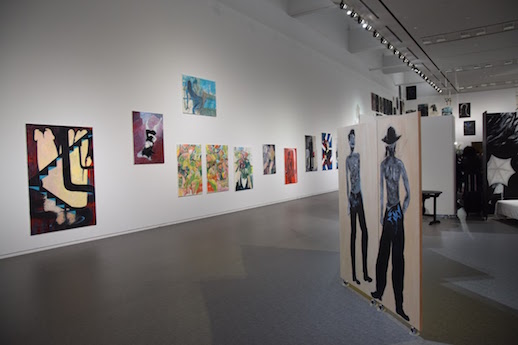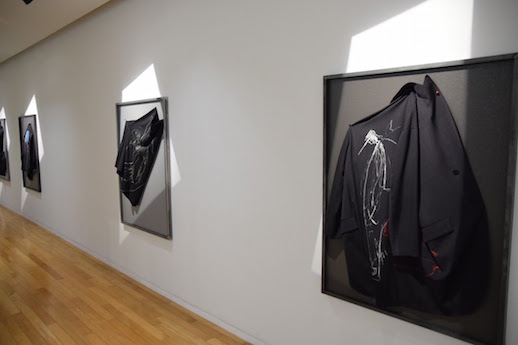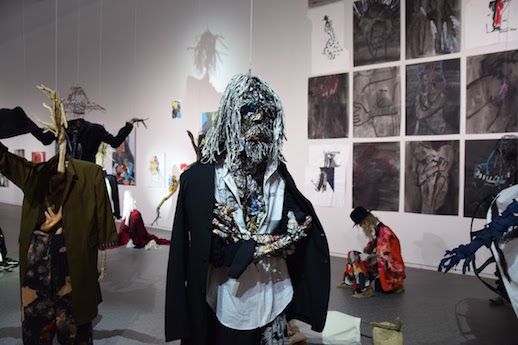Missed Opportunity

The debut of Rei Kawakubo and Yohji Yamamoto at he Paris fashion show of 1981 marked a major turning point in Europe’s acceptance of Japanese designers, and it is Yamamoto whose name graces the show “Painting and Weaving Opportunity,” along with contemporary abstract painter Yuka Asakura. This project was originally spearheaded by critic Seigo Matsuoka at the request of Yamamoto as an exploration of the relationship between painting and weaving in relation to Yamamoto’s clothing. Works on display include: paintings, clothes, sculptures, and installations. It is wonderful to see Tokyo Opera City and the National Art Center holding exhibitions of Japanese fashion designers (Jun Takahashi and Issey Miyake respectively) as art. Fashion may also be viewed as a medium in which art can be made, and Yamamoto, Takahashi, and Miyake all fit this definition.
The minimalist presentation of “Painting and Weaving Opportunity” is a welcoming entry to Yamamoto’s world. You can easily start making allusions to his fashion designs, if not for one thing…the realization that only about 15% of the work is actually Yamamoto’s, with the majority by Asakura. This imbalance is not mentioned in the exhibit’s introduction (the only attempt at a written explanation of the show) until the second-to-last paragraph before the corporate thank yous. There is a complex little map of randomly dispersed black shapes to represent Yamamoto’s works in a vast sea of white ones by Asakura. Sadly, half of the fun is the treasure hunt that ensues figuring out what works are actually Yamamoto’s.

Strictly for the fashion and design aspect of recent collections, it is interesting how Asakura’s paintings manage to work on his clothes. As stand-alone art pieces, the colorful paintings come off jarring in contrast to Yamamoto’s less technical and expressively darker paintings. In fact, the paintings appear amateurish in their realization when directly compared. Asakura’s most successful pieces are the bright abstract expressionist works on large canvases in the exhibit’s second room, completely removed from Yamamoto’s work. Yet they still feel out of place. After researching a bit, it turns out that several of these paintings are from past exhibitions. Yamamoto and Asakura only come off successful as a pair in the dual-sided glass paintings in the opening room, where Asakura’s vivid strokes suit Yamamoto’s equally expressive clothing cuts in fashion sketches. Their works fail to connect again until the final hallway leading to the exit, which features sketches on black paper. Here again, for every Yamamoto sketch there are several more by Asakura.
A collaborative exhibition by artists working in different media at different points in their careers is not necessarily a bad idea; it is just that for such a big name as Yamamoto’s, this is really a Yuka Asakura show. At times you can see the shared inspiration in their works, but more often than not they seem ill suited together. The forced portraits of Yamamoto are cringe-worthy and out-of-step for Asakura, as were Yamamoto’s paintings of a woman’s backside looking out of a window, or two female nudes conjoined in a sea of birds.

A large problem lies in museum’s communication of the show’s content to the public. Most will go strictly as fans of Yamamoto’s fashion expecting something similar to the Jun Takahashi or Issey Miyake shows last year. Visitors dressed head to toe in black Yamamato clothes walked around with puzzled looks on their faces. Nothing about Yamomoto’s process or even where his design sensibilities come from is presented. Of course, unlike Takahashi, this was in no means billed as a retrospective. Even the catalogue attempts no explanation of the exhibition’s objectives, and instead spends more time on its envelope presentation that is clearly in favor of style over substance. This is a shame, since Yamamoto makes us go beyond facades in observing fashion and is often credited with the most creative mind in the industry. This exhibition, meanwhile, felt like a strange Senpai/Kohai (senior/junior) relationship with the younger, less established Asakura doing nearly everything and Yamamoto coming around and co-signing. If anything, this would be the fashion house approach to creation more than a well-intentioned art exhibition.



